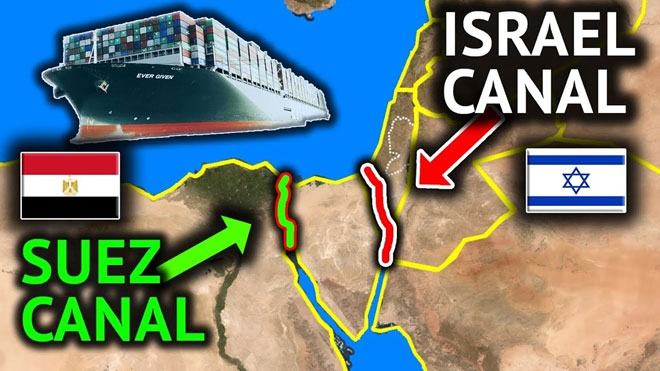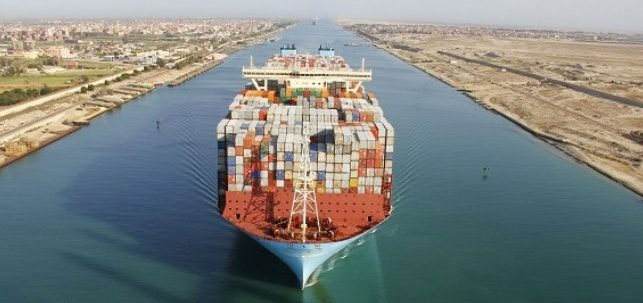However, the grounding of the Ever Given raises a question: If an unexpected incident like this happens again, will the world have to anxiously wait for a successful rescue operation?
West Coast and… the Arctic Ocean
It is easy to see one thing: As Egyptian workers tirelessly “worked day and night” to return the 400-meter-long and 220,000-ton ship back to the ocean, they were not only foregoing food and sleep because the Suez Canal is one of their country’s greatest prides, not only because of the 9 billion USD worth of goods trapped every day, but because the flow of ships through the Suez Canal is closely related to their very livelihood. As Eslam Negm, an Egyptian sailor involved in the dredging rescue, shared: “We—meaning the majority of Egyptians—live off this canal.”
From that, without needing precise figures, anyone can imagine the enormous profits that this vital maritime route brings. Thus, it is no surprise that alternative solutions to the Suez Canal (or at least contingency plans for the worst-case scenario) were immediately proposed in international media.
Leading the charge is Israel. According to The Arab Weekly on March 30, 2021, the Suez Canal blockage sparked discussions about alternative routes, including the Ben Gurion Canal project in Israel, which connects the Red Sea to the Mediterranean (also known as the Israel Canal).
Israel views this route as a competitor to the Suez Canal. Tel Aviv plans to transform the Israel Canal into a multifaceted project, including the construction of small towns, hotels, restaurants, and nightclubs along this waterway.

Outline of the Israel Canal project.
Previously, on March 25, 2021, Business Insider (USA) published the contents of a classified memorandum written in 1963 and declassified in 1996. It revealed that the Lawrence Livermore National Laboratory in the United States had studied a project using nuclear explosions to dig a 160-mile (257 km) canal through the Negev Desert in Israel, connecting the Mediterranean Sea to the Gulf of Aqaba in the Red Sea.
Historian Alex Wellerstein, who also mentioned this file on his personal Twitter account, believes this is a prototype plan. However, in 1967, when the Arab-Israeli war broke out, the Suez Canal had to close for eight years, and no one spoke of the Israel Canal.
This is not surprising, as in the 1960s, trade activities and the volume of goods—especially the interdependence of all factors—were not as rich, diverse, developed, and complex as they are today in the 21st century.
The issue is: Because of involvement with nuclear radiation, there is no guarantee that neighboring Islamic Arab countries (which are still full of suspicion or hostility) would agree to allow Israel to reinitiate the Ben Gurion Canal project.
Meanwhile, while 380 ships were waiting at the Suez Canal, Russia announced: It would bring the Northern Sea Route connecting both the Pacific and Atlantic Oceans to market and committed to ensuring the safety of this new transportation route, as well as guaranteeing that transportation costs would be lower.
This sea route shortens the travel distance by 40% from China through Egypt to Europe, reducing travel time by 15 days. Due to climate change, the amount of ice on this route is decreasing, making navigation increasingly easier.
Russia has committed to sending icebreakers to rescue any merchant ships trapped in ice along the way. Russia plans to use this maritime route to export its oil and gas.
These are inevitable movements arising from reality, as everyone has seen how vulnerable modern global supply chains can be. This reality prompts any country with the means to prepare contingency plans while also seeking opportunities to claim their share of the “logistics pie.”
Enduring Glory
However, we can believe that all Suez Canal projects are perhaps not only of reference value but will never fully replace the maritime route of just 193.3 km that connects the Red Sea to the Mediterranean.
Just like the Panama Canal that traverses Central America, connecting the Atlantic and Pacific Oceans, history and reality have given the Suez Canal an incomparable position against any competitor.
Compared to the Northern Sea Route that Russia intends to implement, the absolute advantage of the Suez Canal is not its immunity to freezing in winter, but rather its proximity to the “oil hub” of the planet. The position of the Suez Canal at the crossroads of the continents of Europe, Asia, and Africa is also extremely important, as North Africa and the Middle East have always been a “hotspot,” a place where the world’s top power centers compete for influence on the global geopolitical map. Moreover, the Mediterranean has been the most significant trade center (if not the most important trade center) of humanity since ancient times, also the birthplace of many ancient civilizations.

19,000 ships pass through the Suez Canal each year
Israel may still proceed with the Ben Gurion Canal excavation. However, “human harmony” will be the biggest obstacle that the Jewish state has to face. On March 29, when Egyptian President El Sisi announced: “Egypt has succeeded in ending the crisis of the grounded ship in the Suez Canal and returning everything to normal. This reassures the entire world about the transportation of goods and their needs through this vital transportation route.” It can be said that he has made all friendly Islamic Arab countries feel at ease to “overlook” any alternative ideas, especially the idea of using another canal for Israel’s benefit. Habits and old relationships, no matter what, still play a core role, even in matters of interest.
Of course, Egypt will have to do much better in its tasks to ensure that as securely as possible, an incident like the grounding of the Ever Given—meaning that global supply chains are disrupted by a single night of strong winds—does not occur again.
However, it is also evident that the era when famous navigators like Vasco da Gama, Bartholomeus Diaz, or Ferdinand Magellan had to sail around the Cape of Good Hope at the southern tip of Africa to reach India is far behind us. Humanity will not return to those days, but it is also not necessarily required to have another route after more than 100 years of familiarity with the winds of Suez…
|
* Annually, the Suez Canal generates an average profit of about 6 billion USD for Egypt, with approximately 19,000 ships passing through, carrying goods equivalent to 10% of global trade volume. In 2020, under the impacts of the COVID-19 pandemic and the paralysis of global trade machinery, this figure still reached 5.61 billion USD. * Because traditional canal digging methods would be extremely costly, the Americans plan to use the Peaceful Nuclear Explosions (PNEs) method. This is a feasible measure, as the nearly 160-mile canal has 130 miles going through uninhabited desert areas where nuclear explosions can be conducted. It is estimated that to dig each mile of the canal, 4 nuclear devices (tentatively called atomic bombs) of 2 million tons of TNT equivalent would be needed. Thus, a total of 520 atomic bombs or 1.04 billion tons of TNT would be required to excavate this canal. |





















































